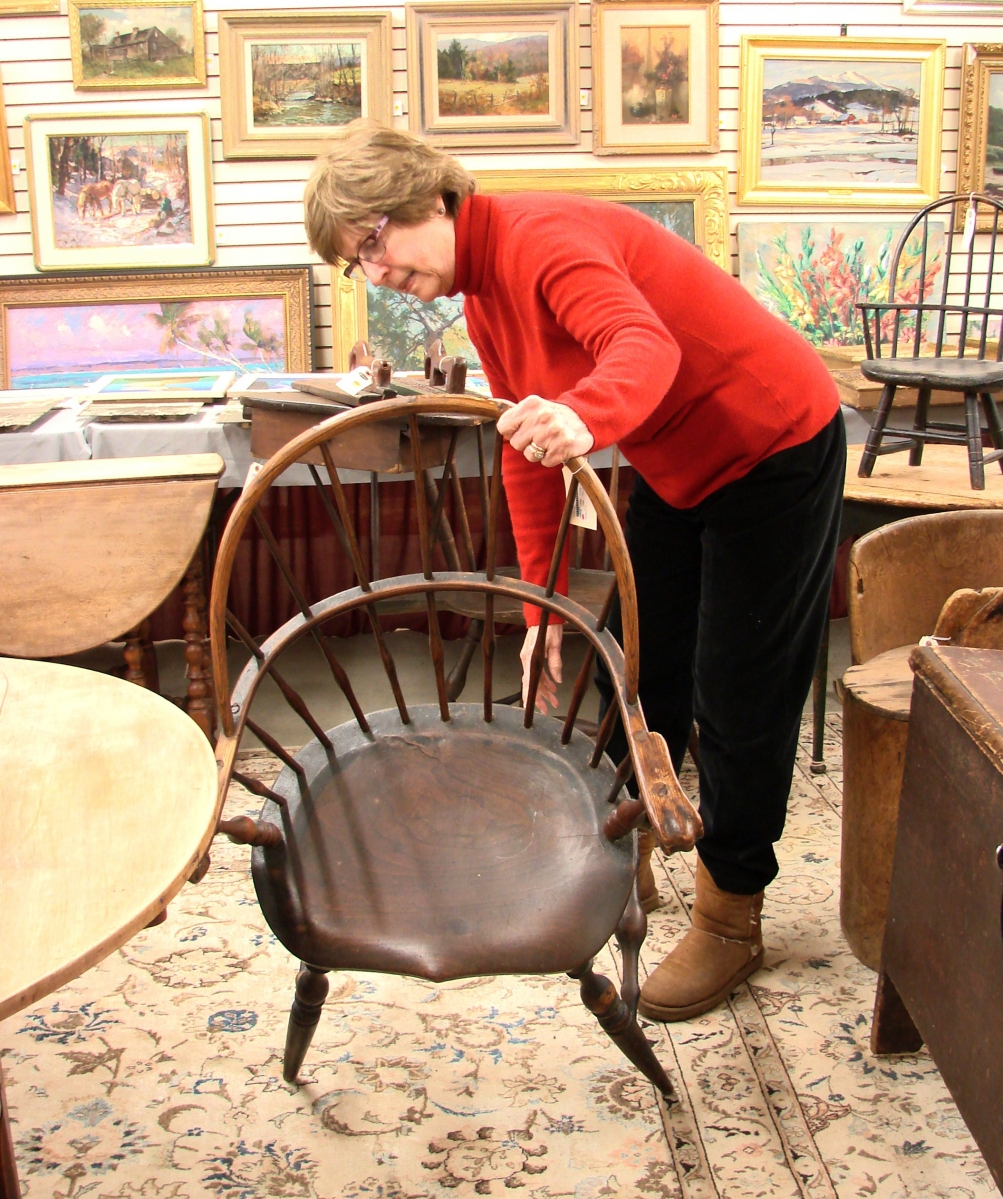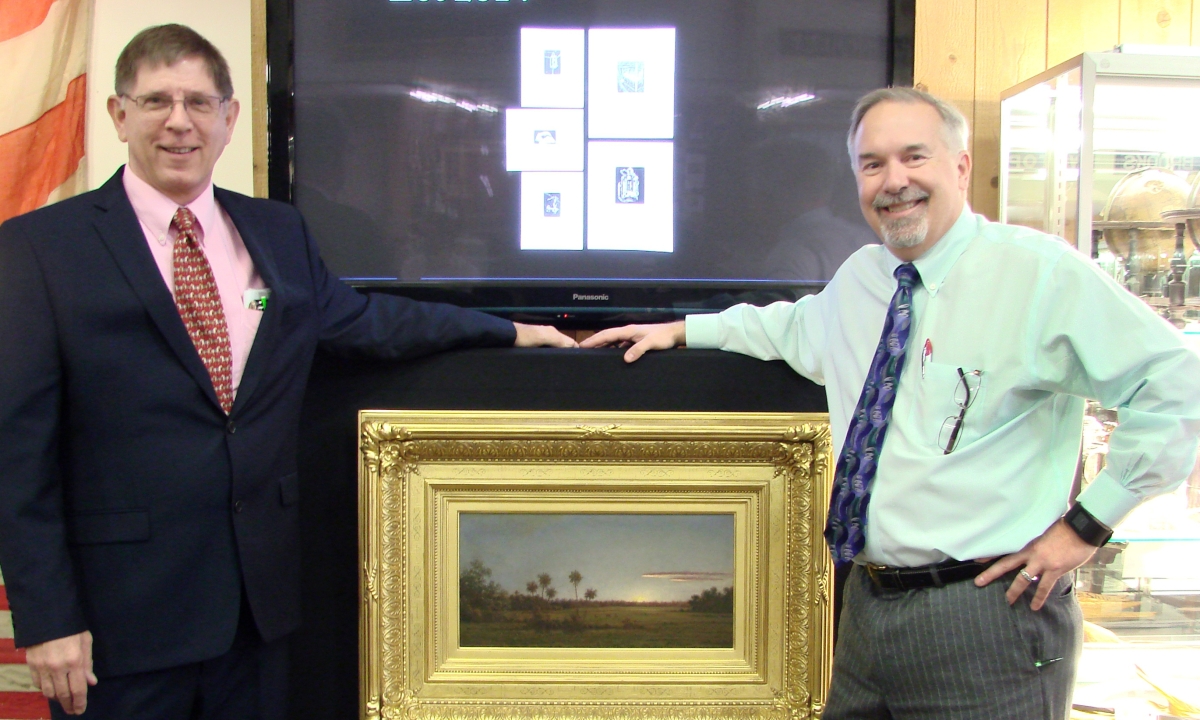
Bill Gage, Julia’s fine art, asian and antiques division department head (at left), is pictured with chief executive officer Mark Ford.
Review by Rick Russack, Photos Courtesy James D. Julia, Inc.
FAIRFIELD, MAINE – Jim Julia’s two-day sale of more than 1,100 lots February 9-10 succeeded in spite of winter weather. The first day was devoted to fine art and Asian antiques. There were major successes in each category, with a Martin Johnson Heade (American, 1819-1904) painting selling for $359,000 and a group of Chinese calligraphic couplets surprising all, as one brought more than $30,000. A disappointment was a bronze by Paul Manship (American, 1885-1966), “Indian Hunter and His Dog” that had been expected to do well during the first day of the sale but failed to meet its reserve.
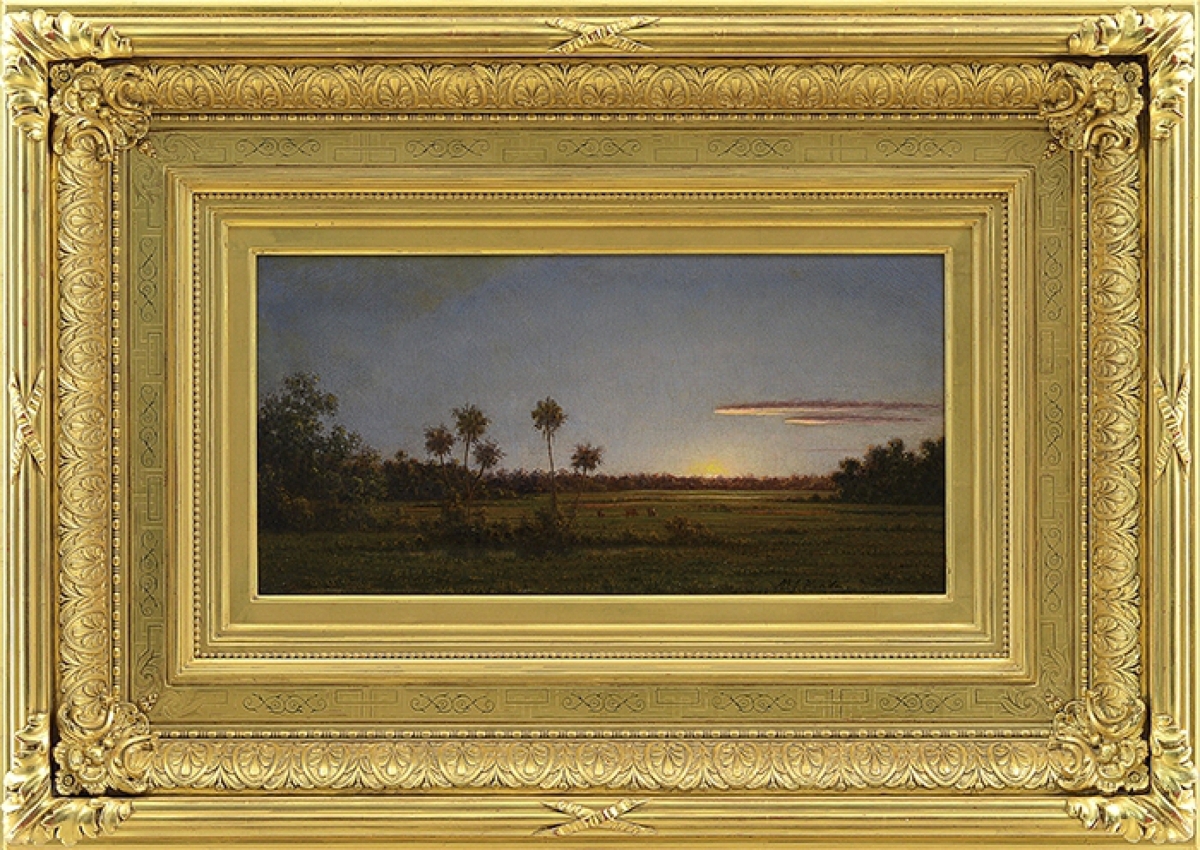
The highest priced lot of the sale, $359,000, was earned by Martin Johnson Heade’s “Florida Pastoral.” It’s a well-known painting, having been illustrated in several works about the artist, as well as having been included in exhibitions of his work.
Day two saw strong prices for a collection of historic flags, including several Confederate examples, major weathervanes, a historic archive of material from the Confederate Secretary of the Navy Stephen R. Mallory, which brought more than $82,000, along with decoys, American furniture, folk art and marine paintings. Julia’s catalogs include comprehensive descriptions of each item, often extending to multiple pages and sometimes with foldout photos. This catalog weighed about four pounds.
Heade’s “Florida Pastoral” was expected to be the top performer of the two day sale and it was, realizing $359,000. It’s a well-known painting, appearing in Theodore Stebbins’ The Life and Work of Martin Johnson Heade: A Critical Analysis and Catalog Raisonne. It had also been in exhibitions and published elsewhere. The provenance included the family of the artist and Kennedy Galleries. Another of Heade’s Florida works, “The Great Florida Sunset” brought nearly $6 million at Sotheby’s sale of the Taubman collection in 2015. Heade’s work in Florida was documented in a 2010 article in the Florida Historical Quarterly.
Works by other well-known American artists did well. “A Hillside Village at Sunset” by Thomas Moran (1837-1926), earned $51,425. An oil by John Singer Sargent (1856-1926) “Donkeys in a Desert, Morocco 1880,” finished at $47,190. “Hot Toddy,” a charcoal by Norman Rockwell, (1894-1978), which was used in a 1949 advertisement in the Saturday Evening Post for Schenley Whiskey, sold for $45,980. A circa 1891 pen and ink with watercolor and gouache, “Whipping In A Straggler” by Frederic Remington (1861-1909), had been used in an 1891 issue of Harper’s Weekly and it sold for $18,150. On the lighter side, a signed, hand colored Peanuts comic strip for a campaign for banning dogs from riding in the backs of pickup trucks, by Charles Schulz (1922-2000), earned $3,933. It had been commissioned by the county of San Diego Bureau of Animal Control.
A White Mountains scene, “Panoramic View of the Mount Washington Valley” by Edward Hill (American, 1843-1923) realized a surprising $16,940 against a $2,000 estimate. It was a scene that Hill painted frequently, done from Artist’s Bluff showing Mount Lafayette, the Profile House, Echo Lake and Franconia Notch. A number of Hill’s paintings hang in the Littleton, N.H., library.
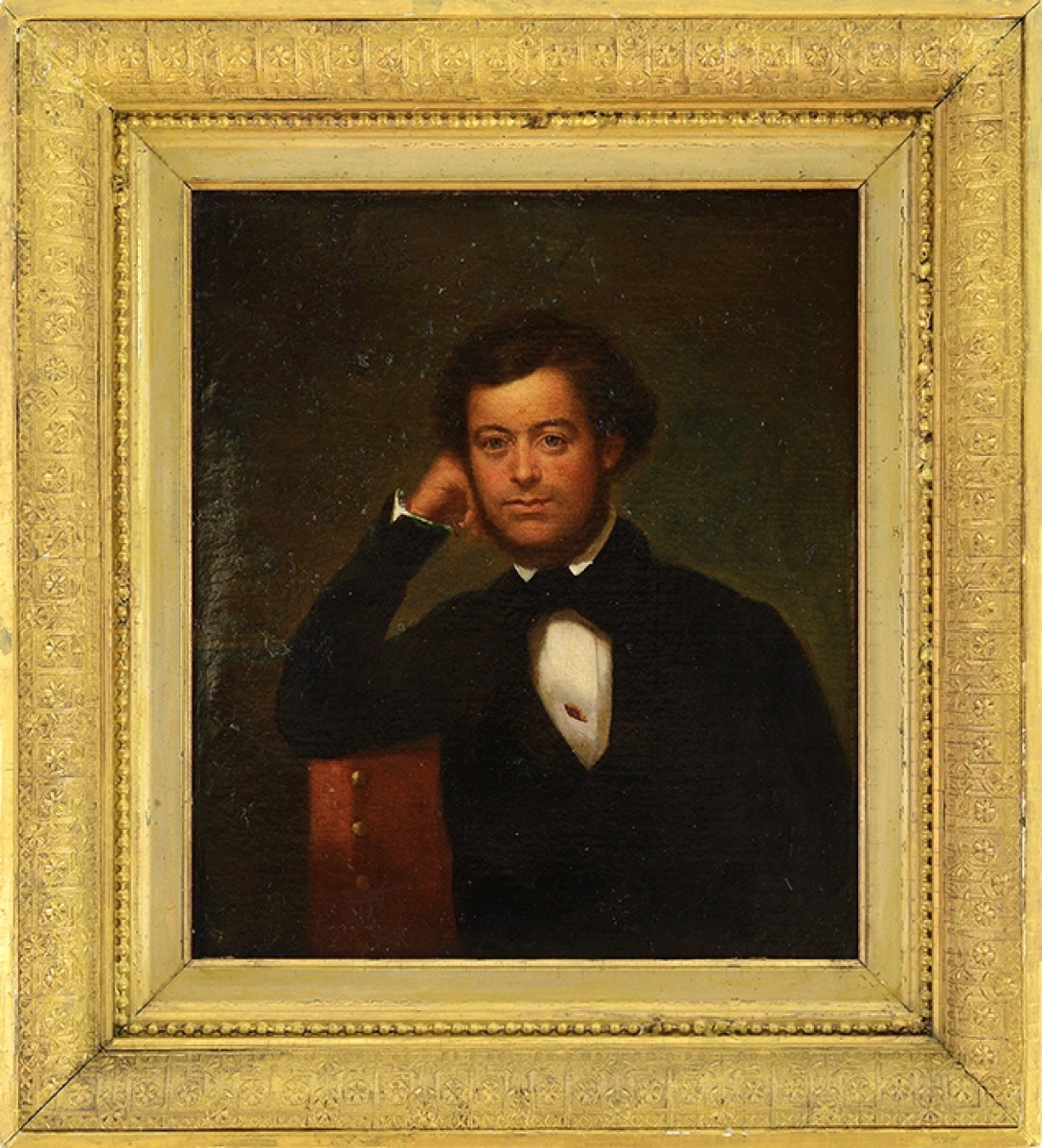
This portrait of Stephen Mallory, Confederate Secretary of the Navy, was part of an archive of related material that included a possibly unique appointment signed by Jefferson Davis and William M. Browne, as Secretary of State. Browne served in that capacity for just a few days in March, 1862. The archive sold for $84,700 against an estimate of $12,000.
There were any number of paintings that sold at very affordable prices. A selection of works by Alzira Boehm Pierce (American, 1908-2010) sold between $605 and $2,723. Several paintings by members of the Rockport School sold at reasonable prices: “Ice Patches Rockport,” by Carl W. Peters (1897-1980) sold for $2,420; “Bass Rocks” by Emile Albert Gruppe (1896-1978) brought $3,025; “Breaking Waves” by Aldro Hibbard (1886-1972) went for $2,118; while another by the same artist, of a coastal shoreline with boats and buildings, earned $9,460. A number of works by American artists failed to meet reserves and can still be purchased online at Julia’s site.
About 150 lots of Asian material were sold on day one. An outstanding Japanese Meiji-period bronze had been promoted as one of the important lots in this portion of the sale and it did not disappoint. The 36-inch bronze by Yoshimitsu, known for his large sculptures of archers and warriors, depicted a Samurai archer with arm extended, holding a bow ready to fire. It came with six arrows, with gilt highlights throughout the piece, with a signature plate on one leg. It realized $24,200.
Another bronze, this one, Twentieth Century Chinese, depicted a seated elder figure with legs crossed and hands resting on his knees. It was 16 inches tall and achieved $16,590. Surprising most was the strength shown by a group of Chinese calligraphy couplets. A pair of scrolls signed by Zuo Zongtang (1812-1885), 88 inches long, reached $30,250 against an estimate of $12,000. Another pair signed by Li Hongzhang (1823-1901) brought $26,620, against an estimate of $7,000.
After the sale, Josh Chamberlain, Julia’s consultant for Asian material, said, “There wasn’t as much Asian material as other sales in the past, but it was a nice cross section of quality pieces. The couplets did very well as they were done by some well-known artists. The best was the couplet done by Zuo Zongtang, who is sometimes referred to as General Tso and General Tso’s chicken is actually named after him. The Japanese bronze archer was wonderful and it was done by a well-respected sculptor.”
Many historically important Confederate and Union items sold on the second day. Of particular interest, and selling for $84,700 was an archive of material that belonged to the Confederate Secretary of the Navy, Stephen R. Mallory. Included were transcribed copies of his diaries, a sword that belonged to him, an early portrait of Mallory and a very rare, possibly unique, appointment signed by Jefferson Davis.
The catalog states, “This is the only appointment signed by Confederate President Jefferson Davis that we are aware of, to any cabinet member. The document is totally done in calligraphy with the applied embossed seal of the ‘Provisional Government Of The Confederate States Of America.’ The document is also signed by William M. Browne as Secretary of State, who later became a Confederate general and was only acting Secretary of State for a few days in March of 1862. It’s doubtful any other document exists with Browne having signed as “Secretary of State.”
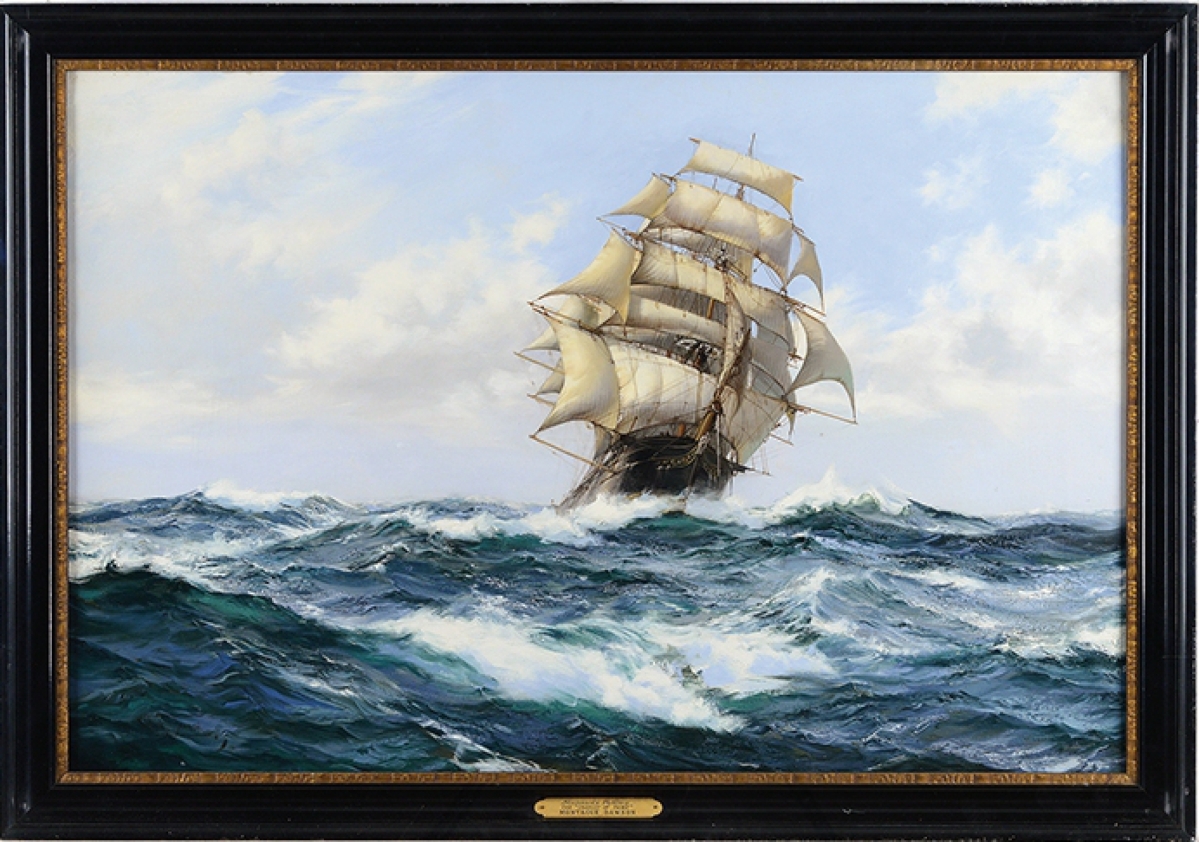
Montague Dawson’s “The Chariot of Fame, Stunsails Pulling,” was signed and had been owned by American Airlines and hung in the Admiral’s Club in the Los Angeles airport. It attained $78,650.
The group of material descended in the Mallory family and had been conservatively estimated at $12,000. An album of autographs collected by Mallory’s daughter, Maggie, sold for $7,865. It was likely assembled when her father was a senator in the 1850s and included signatures of President Polk, James Buchanan, Franklin Pierce, Jefferson Davis, Sam Houston and several other judges and politicians, especially those from Southern states.
Several historic flags from the collection of Timothy Gallagher, Amherst, N.H., grossed $110,500. A rare Confederate 13-star “Stars and Bars” flag sold for $16,335. Thirteen-star Confederate flags are rare and were typically made early in the war when it was envisioned that there would be 13 slave states in the Confederacy. A Grover Cleveland 1884 presidential campaign flag sold for $3,205. It was unusual in that an earlier flag with just 35 stars was used. By 1884, official flags had 38 stars. One of the smallest official Civil War Union army flags, known as a “camp color” flag, with 34 stars sold for $6,655. These flags were used in army camps, usually outside the tent of the commanding officer. A Civil War flag, cataloged as a “whimsical homemade Civil War flag” had 33 stars on one side and 35 stars on the other. The hand-stitched flag was made of different fabrics and sold for $6,655. There were a number of flags issued as additional states joined the union. Each time that happened, a new flag was required.
A few days after the sale, Antiques and the Arts Weekly discussed the collection with Gallagher, who said he has been collecting flags for about 20 years. “I was quite pleased with the overall results and I thought there were a few surprises. Some flags that I thought would do really well didn’t, but others brought quite a bit more than I thought they would. The 12-star Confederate exclusionary flag brought $11,193 – that was a nice surprise. I bought that flag in Canada years ago and I didn’t pay a lot for it. But it was one of those flags that both looked good and told a story. The same thing worked for the ‘inverted star’ Lincoln funeral flag.”
Julia’s catalog stated that this flag was thought to have been flown in Washington during Lincoln’s funeral ceremonies. It was to be hung vertically, with the tip of the star pointing down, as a sign of mourning. It brought the highest price of the collection, $20,570.
“Some of the rarer flags that brought less than I thought, were historically important but not visually exciting,” Gallagher said. “There was a 37-star flag with a handwritten inscription stating that it had been given to its owner on the day that President Garfield was shot. That one brought just $2,370.” He explained that he had kept back about ten flags from his collection to give to his grandchildren. He also said that he thought that Jim Julia did a good job cataloging and marketing the collection and John Sexton, Julia’s flag specialist, was very helpful throughout the process.
The second day of the sale started off with a group of decoys by Portland, Maine, lighthouse keeper Gus Wilson. A black duck in a back-preening pose brought $4,840, and another black duck, having an unusual cantered head, finished at $1,815. Next came about ten lots of birds by master carver Elmer Crowell of East Harwich, Mass. As usual, there was stiff competition for these decoys, with a decorative yellowlegs shorebird with dropped and carved wings going out at $11,495 to one of four active phone bidders. Other Crowell birds also did well, with a decorative killdeer plover, with a rectangular stamp and handwritten signature, finishing at $6,050, and a life-size decorative blue jay bringing the same price.
The top lot from a group of weathervanes was a J. Howard Co. 28-inch horse and rider that attained $66,550. It was accompanied by an original drawing by John Moll, well-known marine artist, showing the weathervane on the well house it was originally installed on in Emerson Point, Md.
The sale was full of other interesting things. A family collection of 39 photos taken during the 1890s Klondike gold rush reached $5,445. An archive of material related to the nuclear submarine Nautilis sold for $6,050. According to the catalog, “Few maritime exploits in history had so startled the world as the silent and secret transpolar voyage of the US Navy’s nuclear submarine Nautilus. This event was the beginning of nuclear arms race that wrote American history for the next few decades…” The material included items inscribed by William R. Anderson, the Nautilus‘ commander, to Admiral Chester Nimitz, regarded as the father of America’s nuclear navy. There was also a spectacular tramp art secretary bookcase, painted black, decorated with five-point stars, pierced tin panels and mare. It earned $9,983.
A large round of applause from the audience greeted Jim Julia when he took the podium moments before the sale began. It was announced that Jim’s wife, Sandy, had just completed a round of cancer treatments and Jim said she was doing well.
After the sale, Bill Gage, department head, who has worked for the company for 22 years said they were pleased overall with the auction’s results. “Sometimes people ask me if we get all this stuff in Maine. We don’t. All of our department heads travel thousands of miles to get stuff together for each auction. We’re looking for the best of the best. The department heads work together to decide in which sale particular items are likely to do their best. It works well for us and this sale was a good example. Several of the items that did not draw bids during the auction have already been sold and we expect that more will be. It happens after every sale.”
All prices reported include the buyer’s premiums. For information, www.jamesdjulia.com or 207-453-7125.

